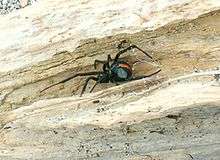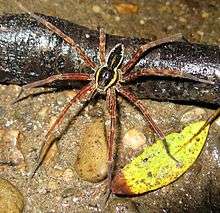Spiders of New Zealand
New Zealand has 1134 described spider species, with an estimated total fauna of 2000 species.[1][2] Over 90 per cent are endemic, and the rest have been introduced through human activities or were natural wind-borne introductions.[2]

The New Zealand spider with the largest leg span is the Nelson cave spider (Spelungula cavernicola), with a leg span of up to 13 centimetres (5.1 in) and a 3 centimetres (1.2 in) body length.
The Australian white-tailed spider, first recorded in New Zealand in 1886, has been falsely attributed as the cause of many necrotising spider bites.[3]
The flat huntsman spider (Delena cancerides), also from Australia, and called the Avondale spider in New Zealand, was accidentally introduced in the early 1920s, possibly in shipments of hardwood logs used for railway sleepers.[4] The huntsman spiders, which are considered harmless to humans, have been collected for use in at least two films.
Very few New Zealand spiders have bites that can cause significant injury to humans, and of these, only one – the katipō – is endemic. Katipō bites have been known to cause systemic effects, such as hypertension, seizure, or coma, though no deaths as a result of katipō bites have been recorded for over 200 years. Its more dangerous close relative, the venomous Australian redback spider, has established a foothold in some parts of New Zealand, notably in Taranaki and Central Otago.[5]
Fishing spiders

There are four spiders in the genus Dolomedes (the fishing spiders), species which have adapted to hunt on the surface of water.
Three of the fishing spiders are widespread on the two main islands of New Zealand. Dolomedes aquaticus grows up to 7 centimetres (2.8 in) across and specialises in open, unforested riverbanks, and lives under rocks within 5 metres (16 ft) of the river. Another species of similar size, Dolomedes dondalei, specialises in forested riverbanks and is also widespread on the mainland. The third and most common species, Dolomedes minor, is not restricted to rivers. Known as the nursery web spider, it makes white nursery webs on shrubs, but is still capable of fishing behaviour. The largest of the New Zealand fishing spiders is Dolomedes schauinslandi and occurs on South East and Mangere islands in the Chatham Islands.[6]
Species
Spider species in New Zealand include:
- Anoteropsis (wolf spiders)
- Celaenia spp
- Cambridgea spp. (sheetweb spider)
- Cryptachaea veruculata
- Delena cancerides (Avondale spider)
- Dolomedes aquaticus
- Dolomedes dondalei
- Dolomedes minor
- Gradungula
- Gradungulidae
- Haurokoa
- Hexathele hochstetteri
- Lamponidae
- Latrodectus katipo (katipō)
- Paradictyna spp
- Paradictyna rufoflava
- Pholcus phalangioides
- Poecilopachys australasia (two-spined spider)
- Porrhothele antipodiana
- Spelungula cavernicola (Nelson cave spider)
- Steatoda capensis
- Trite parvula
- Trite planiceps
- Uliodon spp (vagrant spiders)
See also
References
- Paquin, P., Vink, C.J., Dupérré, N. (2010) Spiders of New Zealand: Annotated Family Key and Species List. Manaaki Whenua Press. vii +118 pp.
- "Spiders". Landcare Research. Retrieved 14 December 2015.
- Rademaker, M. & Derraik, J. G. B. (2009) White-tail spider bites. ACC Review 42: 1-2.
- Rowell and Avilés (1995). "Sociality in a bark-dwelling huntsman spider from Australia, Delena cancerides Walckenaer (Araneae: Sparassidae)". Insectes Sociaux. Volume 42(3): 287-302
- Vink, C. J., Derraik, J. G. B., Phillips, C. B. & Sirvid, P. J. (2011) The invasive Australian redback spider, Latrodectus hasseltii Thorell 1870, (Araneae: Theridiidae): current and potential distributions, and likely impacts. Biological Invasions, 13, 1003-1019.
- Vink, C. J. & Dupérré, N. (2010) Pisauridae (Arachnida: Araneae). Fauna of New Zealand 64: 1-60.
External links
| Wikimedia Commons has media related to Spiders of New Zealand. |
- Spiders of New Zealand at Museum of New Zealand Te Papa Tongarewa
- Nursery Web Spiders from Museum of New Zealand Te Papa Tongarewa Website, July 2008
- Greenwood, Michelle, 2008. Aquatic Assassins: The Secret Life of Fishing Spiders. New Zealand Geographic, 91. (online summary)